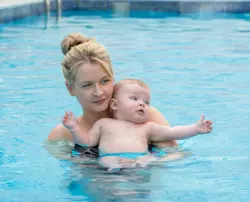
Puddle Ducks Baby & Pre-school and Swim Academy lessons are full of fun, with lots of laughter and games. However, the underlying seriousness of the reasons parents make the decision to take their children to swimming lessons don’t get lost during class. Many of the activities (especially during the younger lessons) are great fun for the little ones but they are picking up a personal survival or water safety skill without even realising, for example:
- Crab Walks teach them how to hold on to the side and move along to a point where it is safe to climb out.
- Blowing Bubbles teaches them how to breath out underwater.
- Cowboy Rides teach them how to hold on to an adult for safety.
- Learning to kick to the surface and turn after jumping in teaches them how to return to safety.
In teaching these skills to your children fro m as young an age as possible, they become second nature, and if the worst was to happen and they were to fall into water, they would instinctively know what to do.
m as young an age as possible, they become second nature, and if the worst was to happen and they were to fall into water, they would instinctively know what to do.
 On top of the personal survival and lifesaving skills that are regularly taught in lessons, as well as the water confidence that is picked up along the way, we hold 3 Pyjama Weeks a year, where swimmers go to their swimming lessons in their PJs. This gives all our swimmers a regular session where the babies/children are exposed to what it might feel like to be in the water with their clothes on. We do not positively encourage our swimmers to jump into the water whenever they can fully clothed – quite the opposite – but we can provide them with the opportunity to see how it would feel to be in the water, following an accidental submersion/fall into water, showing them that they can still swim, practice turning, etc.
On top of the personal survival and lifesaving skills that are regularly taught in lessons, as well as the water confidence that is picked up along the way, we hold 3 Pyjama Weeks a year, where swimmers go to their swimming lessons in their PJs. This gives all our swimmers a regular session where the babies/children are exposed to what it might feel like to be in the water with their clothes on. We do not positively encourage our swimmers to jump into the water whenever they can fully clothed – quite the opposite – but we can provide them with the opportunity to see how it would feel to be in the water, following an accidental submersion/fall into water, showing them that they can still swim, practice turning, etc.
 Despite the hard work of our 300 swimming teachers, and the others through the world, accidental drowning is still the 3rd highest cause of accidental injury death, with an estimated 360,000 deaths each year. There are also multiple forms of drowning, for example hyponatremia, secondary drowning (both of which you can read more about here), and shallow water blackout.
Despite the hard work of our 300 swimming teachers, and the others through the world, accidental drowning is still the 3rd highest cause of accidental injury death, with an estimated 360,000 deaths each year. There are also multiple forms of drowning, for example hyponatremia, secondary drowning (both of which you can read more about here), and shallow water blackout.
Shallow water blackout occurs when a person holding their breath underwater for a period of time faints due to a lack of oxygen to the brain, and their lungs then take on water while they are unconscious. It is especially seen in competitive swimming, but can affect any holding their breath, including those playing breath-holding games with their friends and family.
 There’s a lack of awareness about it, so an organisation called Shallow Water Blackout Prevention are working hard to educate people around the globe. They are based in the USA but have recently appointed a representative to the UK to help raise awareness in this country, and that person is our very own Technical Director, Ali Beckman! You can read all about Ali’s appointment here and the work Shallow Water Blackout Prevention do here.
There’s a lack of awareness about it, so an organisation called Shallow Water Blackout Prevention are working hard to educate people around the globe. They are based in the USA but have recently appointed a representative to the UK to help raise awareness in this country, and that person is our very own Technical Director, Ali Beckman! You can read all about Ali’s appointment here and the work Shallow Water Blackout Prevention do here.
We have plenty of resources on our website to answer any questions you may have about water safety, such as our water safety tips, our FAQs, this blog about swimming whilst on holiday, and more. We also have a Baby & Child Swimming Advice group on Facebook where you can ask questions and join in the discussion, and your can always get in touch with us as well. There are also resources across the internet, such as the RNLI's Respect the Water campaign.


